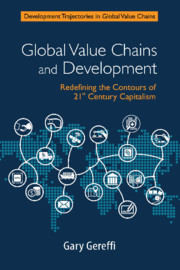Book contents
- Frontmatter
- Dedication
- Contents
- List of Tables
- List of Figures and Boxes
- Foreword
- Acknowledgments
- Sources
- 1 The Emergence of Global Value Chains: Ideas, Institutions, and Research Communities
- Part I Foundations of the Global Value Chain Framework
- Part II Expanding the Governance and Upgrading Dimensions in Global Value Chains
- 5 The Global Economy: Organization, Governance, and Development
- 6 Local Clusters in Global Chains: The Causes and Consequences of Export Dynamism in Torreon's Blue Jeans Industry
- 7 Development Models and Industrial Upgrading in China and Mexico
- 8 Economic and Social Upgrading in Global Production Networks: A New Paradigm for a Changing World
- 9 Regulation and Economic Globalization: Prospects and Limits of Private Governance
- 10 Economic and Social Upgrading in Global Value Chains and Industrial Clusters: Why Governance Matters
- Part III Policy Issues and Challenges
- Co-authors
- Index
10 - Economic and Social Upgrading in Global Value Chains and Industrial Clusters: Why Governance Matters
from Part II - Expanding the Governance and Upgrading Dimensions in Global Value Chains
Published online by Cambridge University Press: 09 November 2018
- Frontmatter
- Dedication
- Contents
- List of Tables
- List of Figures and Boxes
- Foreword
- Acknowledgments
- Sources
- 1 The Emergence of Global Value Chains: Ideas, Institutions, and Research Communities
- Part I Foundations of the Global Value Chain Framework
- Part II Expanding the Governance and Upgrading Dimensions in Global Value Chains
- 5 The Global Economy: Organization, Governance, and Development
- 6 Local Clusters in Global Chains: The Causes and Consequences of Export Dynamism in Torreon's Blue Jeans Industry
- 7 Development Models and Industrial Upgrading in China and Mexico
- 8 Economic and Social Upgrading in Global Production Networks: A New Paradigm for a Changing World
- 9 Regulation and Economic Globalization: Prospects and Limits of Private Governance
- 10 Economic and Social Upgrading in Global Value Chains and Industrial Clusters: Why Governance Matters
- Part III Policy Issues and Challenges
- Co-authors
- Index
Summary
Introduction
Upgrading through global value chains (GVCs), or moving to higher value activities, has become important for economic development and job creation in the global economy, where competition remains intense and production has become fragmented and geographically dispersed (Cattaneo et al., 2013). Linking lead firms in GVCs with small and medium suppliers in diverse local contexts is a major business challenge in different types of industries, whether characterized by producer-driven chains like automobiles, electronics, or shipbuilding for whom finding and nurturing technically capable local suppliers is a requisite of global supply chain management for manufacturers who play a leading role in determining what and how to produce (Contreras et al., 2012; Sturgeon, 2003; Sturgeon et al., 2008), or in buyer-driven chains like apparel and footwear, where low cost is a major driver and retail buyers govern how the chains work (Bair and Gereffi 2001; Schmitz, 2004, 2006), or fresh produce and food products, where safety and quality standards are of utmost concern for supermarkets and their customers (Humphrey and Memedovic, 2006).
In order to maintain good supplier relationships in all of these settings, GVC lead firms have developed more active strategies of corporate social responsibility (CSR) (van Tulder, 2009). While CSR is a multifaceted notion, it generally refers to ‘the responsibility of enterprises for their impacts on society’ (European Commission, 2011). It encompasses a wide range of efforts through which firms seek to integrate social, environmental, ethical, and human rights as well as consumer concerns into their core business practices. The goal is to maximize the benefit of shared value for a broad set of stakeholders, including owners, shareholders, and the wider society, while reducing potential negative impacts of corporate business practices to a minimum.
There is a growing concern, however, that economic upgrading—countries and firms moving to higher value activities in GVCs with improved technology, knowledge, and skills (Gereffi, 2005: 161)—is no longer sufficient for sustainable CSR in global supply chains, given accumulating evidence and recent exposés about child labor, vulnerable workers, and abysmal working conditions in many export-oriented clusters located in developing countries (see Lund-Thomsen and Lindgreen, 2014; Lund-Thomsen and Nadvi, 2010a). Improving both economic and social conditions for workers and communities linked to GVCs is a vexing development problem, and it has attracted considerable attention by researchers, policy makers, and donor communities.
- Type
- Chapter
- Information
- Global Value Chains and DevelopmentRedefining the Contours of 21st Century Capitalism, pp. 276 - 302Publisher: Cambridge University PressPrint publication year: 2018



